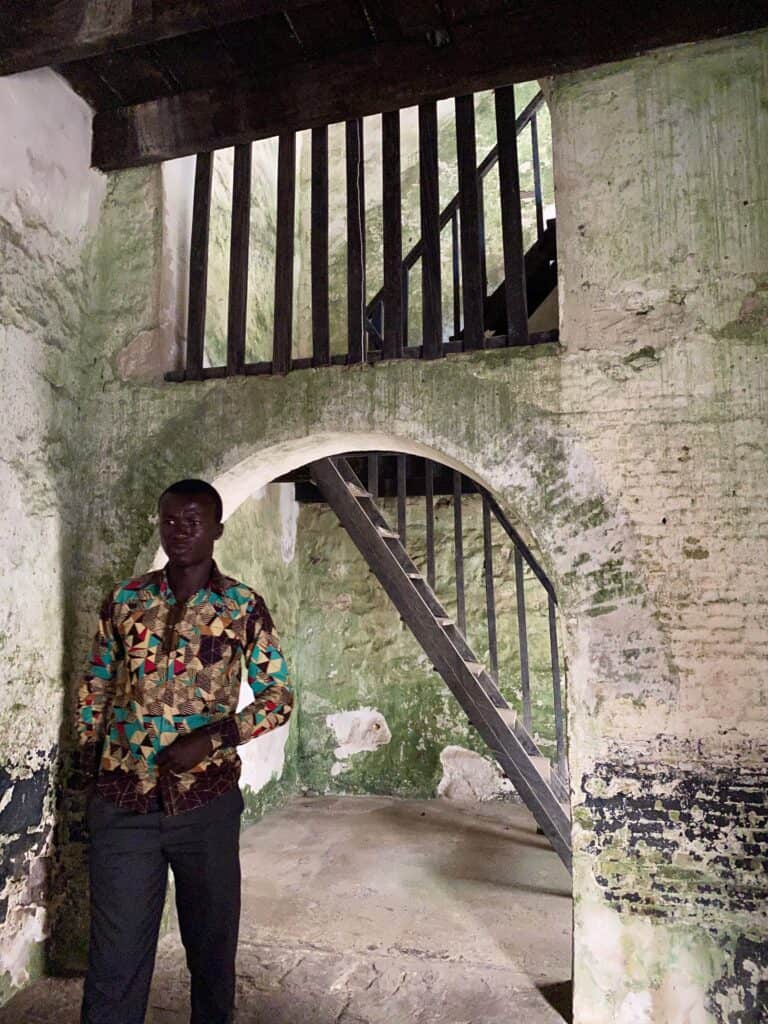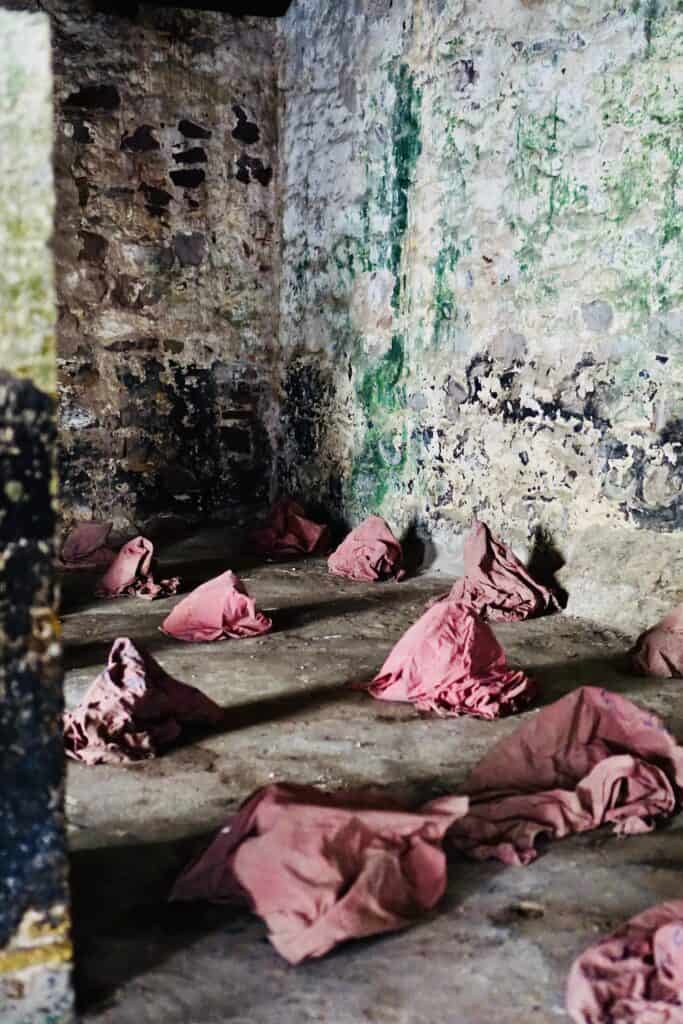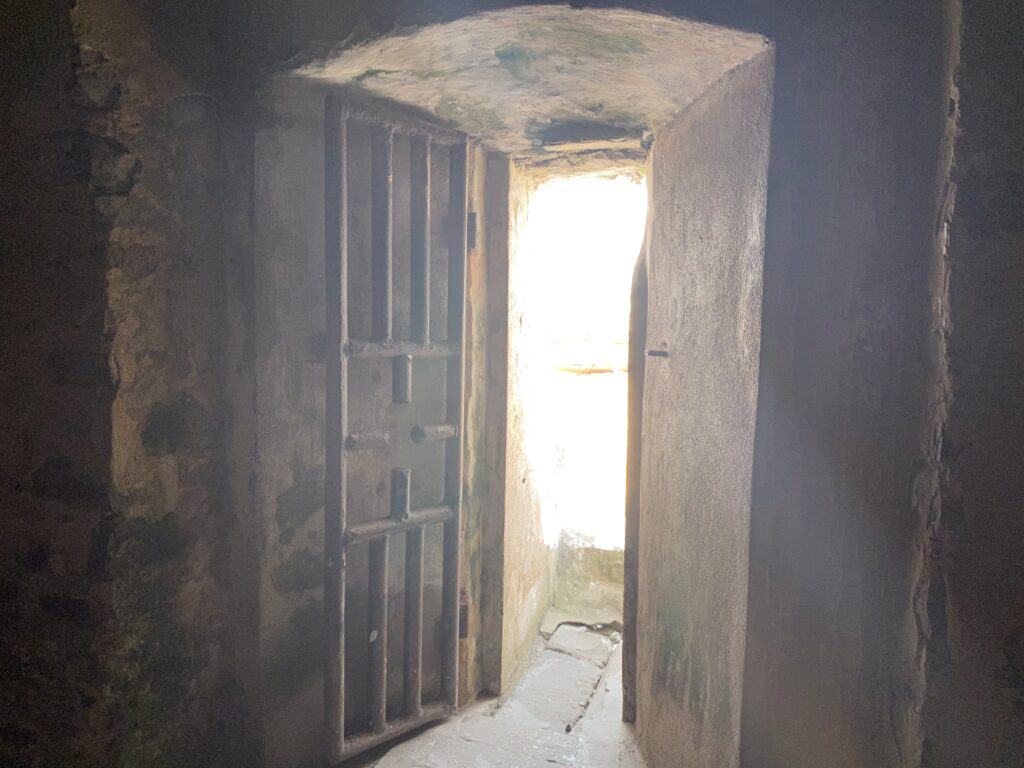The History of Elmina Castle: Ghana’s First Slave Castle

Elmina Castle, perched on the southern coast of Ghana, harbors a harrowing history that is intertwined with the dark saga of the African slave trade. This UNESCO heritage site was established by the Portuguese in the 15th century. Elmina now stands as one of the earliest and most enduring European constructions in sub-Saharan Africa.
This post will offer a deep dive into the history of Elmina Castle, exploring its haunting past, the impacts it had on the fate of countless African lives, and its significance in the global narrative of human rights and freedom. Elmina is now an historical museum, so this post will also cover details on how to visit this important site as well.

Early History of Elmina Castle
Arrival of the Portuguese in Africa
The Portuguese’s arrival in Africa marked the beginning of a new epoch in the continent’s history. In the 15th century, under the patronage of Prince Henry the Navigator, Portuguese explorers began to navigate the west coast of Africa. Their primary objectives were to discover a sea route to Asia, establish trade relations, spread Christianity, and gain geopolitical advantages over other European powers.
The Portuguese reached Elmina, present-day Ghana in 1471, establishing their first permanent base there. They named it “Sao Jorge da Mina,” later known as Elmina Castle, signifying “the Mine” in reference to the region’s abundant gold reserves.
The Construction of Elmina Castle
The construction of Elmina Castle commenced in 1482, under the governance of Portuguese King John II. A pre-existing trading post was fortified into a proper castle, making Elmina Castle the oldest European building in Sub-Saharan Africa. The structure was designed primarily for trade, but its strategic location and solid fortification eventually made it a pivotal focal point in the emerging Atlantic slave trade.
Built using local labor and materials, the Castle fused European medieval and African architectural styles. It featured a chapel, the Church of Santa Maria, living quarters, storage rooms, and dungeons for slaves. Alongside its primary function as a trade hub, Elmina Castle became a chilling symbol of the harrowing human rights abuses inflicted during the Atlantic slave trade.

Initial Use of Elmina Castle
In its early years, before the advent of the Atlantic slave trade, Elmina Castle served as a bustling center of commerce. Its primary function was to facilitate trade between the Portuguese traders and the local African populations. The Castle’s enviable location near the Gold Coast provided access to a wealth of gold, ivory, and spices, which were highly sought after by European merchants.
The Portuguese utilized the fort as a trading post, where goods from both continents were bartered. The Castle’s upper levels housed Portuguese officials and traders, while the lower levels were used to store traded goods, demonstrating a dual purpose of both administration and trade.
Role of Elmina Castle in the Slave Trade
Elmina’s Transition to a Slave Castle
The transition of Elmina Castle from a trading post to the first European slave-trading post was a grim reflection of the shifting dynamics in global trade during the 16th and 17th centuries. As European powers, including the Portuguese, began to establish colonies in the Americas, the demand for labor in these new territories increased dramatically. Simultaneously, the indigenous populations of the Americas were being decimated by diseases brought over from Europe, creating a severe labor shortage.
To meet this growing demand, the European powers turned to Africa, marking the beginning of the brutal Atlantic slave trade. Elmina Castle, with its strategic location and formidable fortifications, quickly became a significant node in this horrific network. Its dungeons, initially designed for storing goods, were repurposed to hold enslaved Africans before they were transported across the Atlantic.

The Portuguese, and later the Dutch and the British, who took control of the castle, exploited the existing local conflicts and rivalries to their advantage. They supplied weapons and other goods to local African leaders in return for slaves. In addition, they also captured locals against their will as well. This marked a tragic turning point in Elmina Castle’s history, transforming it from a vibrant hub of trade to a place of suffering and desolation.
With this transformation, Elmina (like Cape Coast Castle) served as the holding place for slaves after their last bath and before the treacherous journey to the “New World” in slave ships in what became known as the Middle Passage. This meant transporting these people like human cargo to North America and South America.

Elmina as a Slave Castle
LIVING CONDITIONS OF SLAVES IN ELMINA CASTLE
The living conditions that enslaved Africans had to endure at Elmina Castle were beyond inhumane. The castle’s dark dungeons, originally meant for storing goods, were cramped, dark, and poorly ventilated. These chambers were overcrowded, with as many as 200 men or women confined in a single room, forced to live in their own filth as there were no provisions for sanitation. There was not even enough space for the enslaved people there to lie down to rest. The absence of proper ventilation and sanitation led to the outbreak of diseases, leading to a high mortality rate among the captives.


Furthermore, the slaves were given meager rations, often just enough to keep them alive for the journey across the Atlantic. The lack of adequate nutrition compounded the health issues they were already facing due to unsanitary conditions. Individuals who tried to resist or rebel were severely punished, usually in public, to serve as a deterrent to others.
Despite the unimaginable suffering, the enslaved Africans displayed immense resilience. They nurtured their spirit of resistance and their cultural identities, often covertly. Their stories of survival form a crucial part of the history of Elmina Castle, a chilling testament to human cruelty and resilience in the face of adversity.
ROOMS IN ELMINA CASTLE
Elmina Castle housed a range of rooms that served various functions. Central to its design were the dungeons, holding cells for enslaved Africans. As mentioned above, these areas were often overcrowded, with inhumane conditions that resulted in high mortality rates. Above the dungeons were the storage rooms, packed with barrels of gunpowder, food supplies, and other goods vital for the Castle’s operation.
The living quarters, designed for European occupants, present a stark contrast. These rooms were far more spacious and comfortable. They included the Governor’s Chamber, a room lavishly furnished to accommodate the Portuguese overseers, and the Casa da Torre, a large living area with panoramic views of the sea.
The chapel, Church of Santa Maria, was another key room inside the Castle. Despite the atrocities committed within the Castle’s walls, the chapel stood as a place of worship and spiritual refuge for the Castle’s European occupants. This co-existence of a holy site alongside spaces of extreme human suffering further underscores the grim irony of the Castle’s history.
Facts About Elmina Castle
Elmina Castle Location
The current day site of the castle is in the town of Elmina, located in the Central region of Ghana. This town is located on the western coast of present-day Ghana. Perched on the edge of a rocky peninsula, the castle overlooks the Atlantic Ocean, providing a strategic vantage point for controlling sea trade routes.
The region’s tropical climate and its proximity to the Gulf of Guinea further cemented Elmina as a key trading point during the colonial period. The town is approximately 13 kilometers west of Cape Coast, the regional capital, making it accessible for both local and international visitors.
Outside the castle you will see many fishing boats, given the castle’s location on the coast. There are many who make their livelihoods fishing in this area.

Elmina Castle Size
Elmina Castle, one of the largest and oldest European structures in sub-Saharan Africa, spans an impressive area. The Castle is configured around several large courtyards, with its various rooms and spaces extending over an estimated 10,000 square meters.
Despite the Castle’s robust stone walls reaching heights of up to 10 meters, its fortress-like exterior masks an expansive, maze-like interior. As a testament to its historical significance and large scale, Elmina Castle was designated as a UNESCO World Heritage Site in 1979.
Dates of Use
Elmina Castle served as a functioning fortification for several centuries. The Castle’s initial construction was completed by the Portuguese in 1482, making it the first European structure of its kind in sub-Saharan Africa. For over 300 years, until 1814, it remained a significant hub for European slave traders.
It was then taken over by the Dutch and later the British, who used it until Ghana’s independence in 1957. Throughout these centuries, the Castle gained notoriety for its role in the transatlantic slave trade, housing and transporting millions of African slaves. It is now a historical site and serves as a profound reminder of the human rights atrocities that occurred during this period.
Visiting Elmina Castle Today
In recent years (over the 90’s) the Ghanaian government spent time renovating the castle. Today, Elmina Castle a very popular tourist destination in the country. Visitors from around the world journey to visit this site, which now serves as a museum. It is particularly popular with Black Americans whose heritage comes from this very place. Guided tours offer deep insights into the Castle’s past, recounting the harrowing tales of enslaved Africans while also highlighting their indomitable spirit.
The tour takes you through the various rooms, dungeons, and quarters, culminating in the hauntingly symbolic “Door of No Return,” through which countless Africans were forced onto ships, never to return to their homeland. There is also a gift shop on the site, if there are souvenirs you’d like to purchase on your visit there.

Visiting Elmina Castle is not only a historical exploration but also an emotional journey. On my visit here, I could not help but reflect on my ancestors who had to go through this terrible experience in order for me to be alive today. The stark contrast between the austere dungeons and the opulent quarters is a chilling reminder of the inequality and inhumanity that once prevailed.
Despite its grim past, the Castle’s imposing architecture and panoramic views of the Atlantic Ocean lend it a certain somber beauty. The awareness and education it fosters about the transatlantic slave trade make it an important place to visit, to remember the past and ensure that such atrocities are never repeated in the future.
The Best Elmina Castle Day Tour
If you are fortunate to visit this site, I highly recommend you take a guided tour of the castle. I did this when I was there, and found it incredibly insightful. Our tour guide really brought the experience of what it was like to be held captive in the castle to life.
Know that if you book your tour in advance, the entrance fees will be covered as part of the full experience, along with transportation from where you are staying. If you are staying in Accra, there are also a variety of ways to get from Accra to Elmina Castle as well, given that it is where most start their trip to Ghana.
The Best Tour to Elmina Castle
Explore the cultural heritage of Cape Coast by visiting the castles there on this round trip tour from Accra to Cape Coast. In addition to transportation to a variety of sites, you’ll get a private tour guide as well.
During this experience you will:
- Visit Elmina Castle
- Vist Cape Coast Castle
- Visit Kakum National Park
- Visit Has Cottage Botel
Admission to each of the sites, round trip fare from Accra to Cape Coast, as well as drinks and snacks are included in the price of the tour.
Frequently Asked Questions About Elmina Castle
Elmina Castle, also known as St. George’s Castle, is one of the oldest European buildings outside of Europe. Built by the Portuguese in 1482, this makes the castle over 535 years old. Its long history encompasses significant events from the era of exploration to the colonial period and beyond.
The name “Elmina” originates from the Portuguese language. It is derived from the term “Da Costa de el Mina de Ouro,” which translates to “The Coast of the Gold Mines.” The Portuguese named it so, reflecting the region’s abundance of gold resources that were of significant interest to European explorers during the era of the castle’s construction.
The slaves took their last bath at a place now known as “Assin Manso Slave River” in Ghana. This site was a significant area where slaves were washed before they were auctioned off to slave traders. Today, it stands as a commemorative site, reminding us of the dark history of the slave trade.
The Portuguese were the first Europeans to settle in Elmina. They arrived in the late 15th century and constructed Elmina Castle, also known as the St. George Castle, in 1482 as a trading post. Over time, it became a significant hub for the gold and slave trade.
In Summary | The History of Elmina Castle
In conclusion, Elmina Castle stands as a haunting reminder of a grim past, but also an essential symbol of resilience and the human spirit. Its intricate history, from its initial establishment by the Portuguese in the era of exploration to its role in the gold and slave trade, offers a profound historical lesson.
If you do have the opportunity, I highly recommend that you take some time to visit Elmina Castle for yourself. From my personal experience, it can be a very moving and insightful experience to see for yourself. The castle, with its deep-rooted stories and legacy, compels us to remember, learn, and grow towards a future of unity and respect for all mankind.

Related Posts on Ghana:
- The History of Cape Coast Castle
- One Week in Ghana
- Historical Sites in Ghana
- Assin Manso River Slave River Tour
- Where to Eat in Accra
- Is Ghana a Third World Country?
- How to travel from Accra to Cape Coast
- The Best Places to visit in Accra
- Tourist Sites in Ghana
- Best City Tour of Accra
- Best Boutique Hotels in Accra
African Travel Guides



